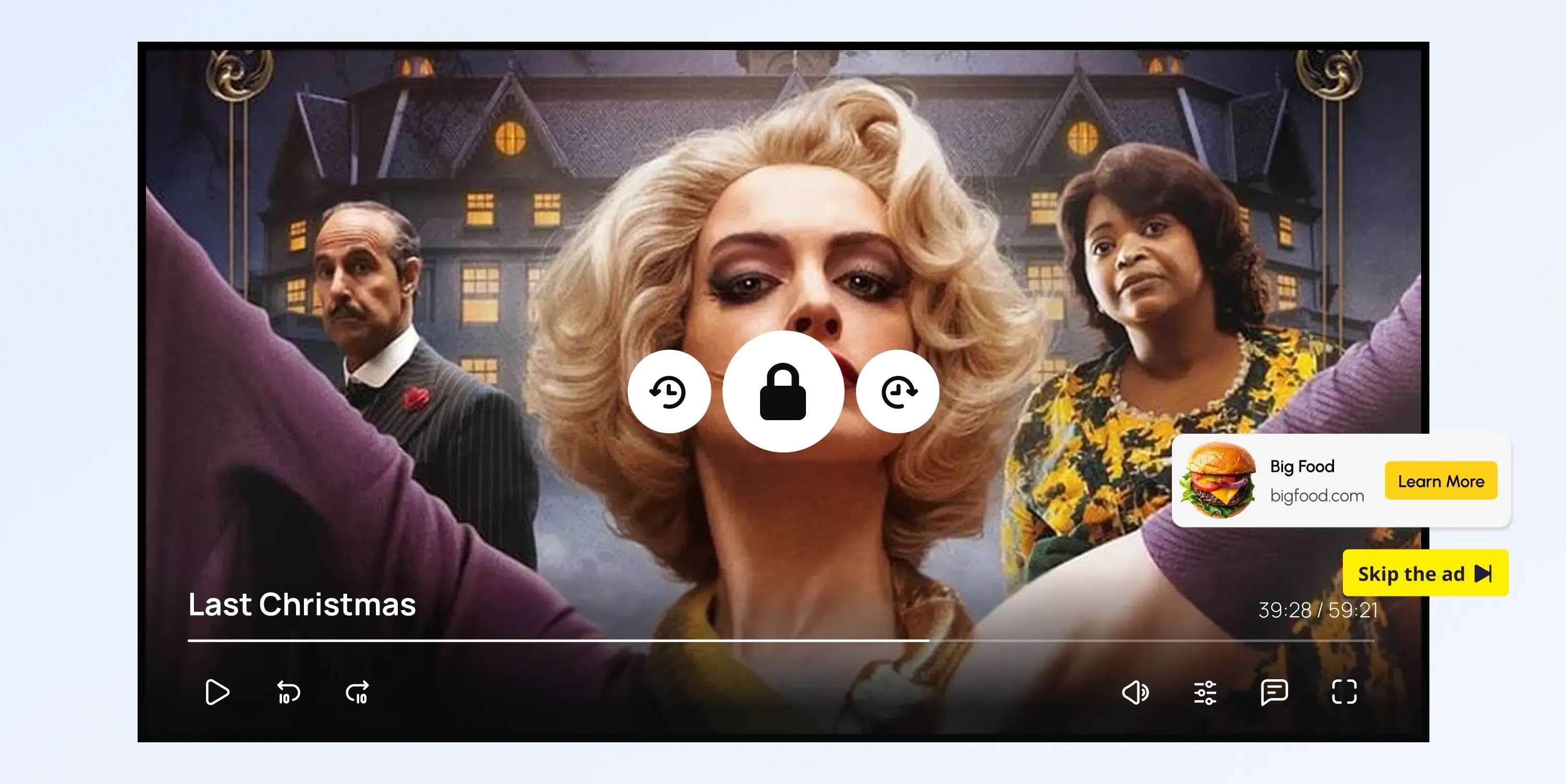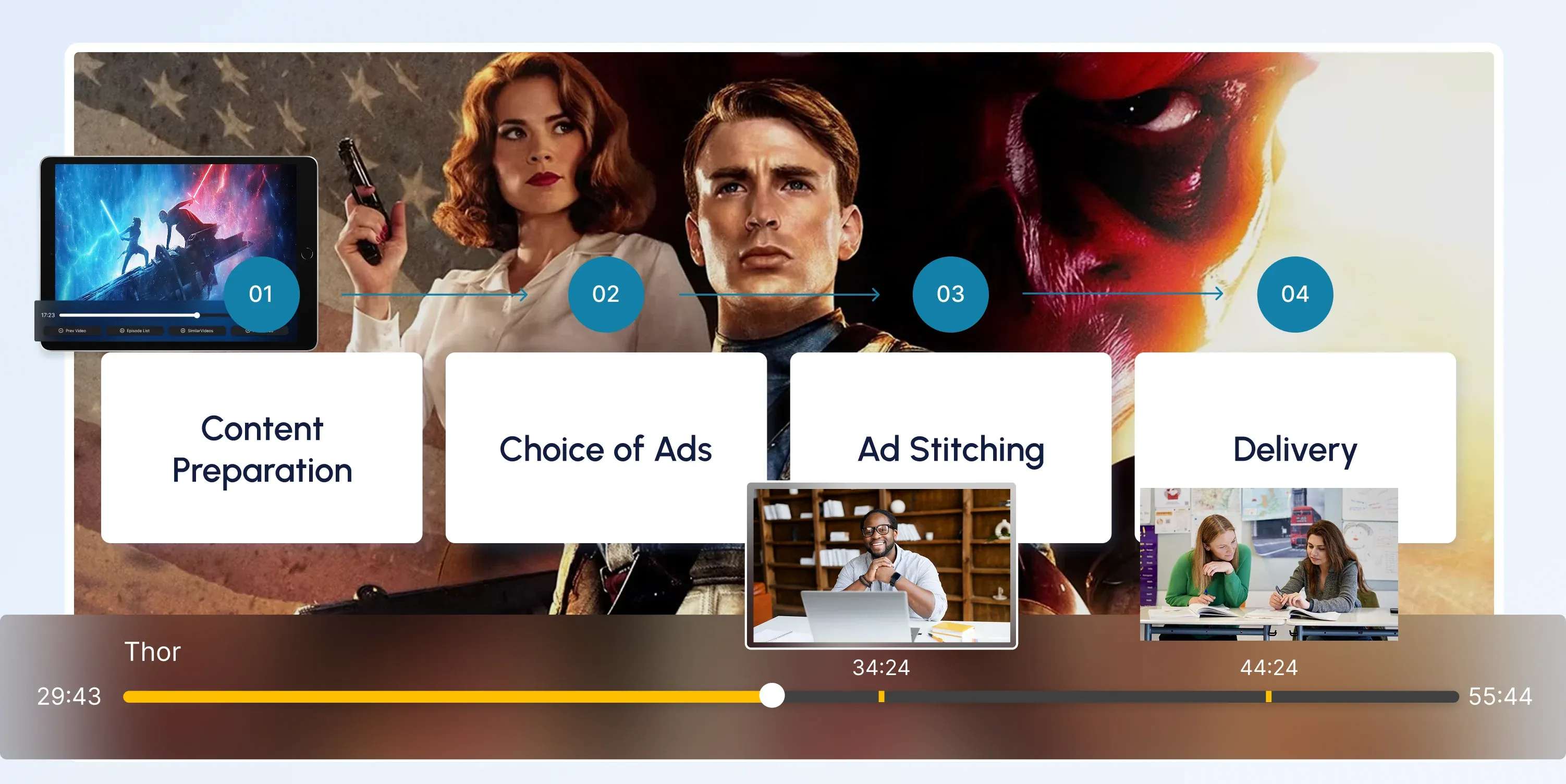Glossary term
SSAI (Server-Side Ad Insertion)

What Is SSAI?
SSAI (Server-Side Ad Insertion) is a server-side technology that inserts ads into video content directly on the server before it is delivered to the viewer.
SSAI Notes
1. SSAI works by fetching ads from one or more ad servers and stitching those ads into the video content as a single stream. This stream is then delivered from the server or cloud to the user.
2. SSAI is used to insert advertising in connected TVs, set-top boxes, game consoles, and other consumer electronic devices that lack client-side capabilities and/or thwart ad blocking.
3. In SSAI, the video player can’t handle ad tracking like it does in client-side setups, and the ad-stitching server doesn’t see traditional ad tags. Instead, it tracks ads by using other methods to identify the device playing the ad.
How Does SSAI Work?
With SSAI, when a user requests playback, the server fetches targeted ads from an ad server, merges them with the content, and delivers the combined stream through a CDN.
Here is how it works:
Step 1. Ad Decisioning
The SSAI server requests personalized ads from an Ad Decision Server (ADS) based on user data, device type, content, etc.
Step 2. Ad Stitching
This part is the heart of SSAI: The server stitches the ads and content into a single, continuous stream, preventing ad blockers for a seamless playback experience.
Step 3. Manifest Manipulation
For HLS or MPEG-DASH streams, SSAI modifies the manifest file (e.g., .m3u8 or .mpd) to include ad segments.
Step 4. Encoding and Transmuxing (an extra step)
Ads and content might need to be encoded in compatible formats or transcoded to match the delivery format.
Step 5. Content Delivery via CDN
The final stitched stream (ads + content) is served to the viewer through a content delivery network (CDN).
Supporting Technique: Video Pre-Loading
Pre-loading refers to loading video content (or ads) in advance so it's ready to play without buffering. It can be applied to both the ads and the content.
Video pre-loading is NOT a part of SSAI itself, but:
- It enhances playback performance during SSAI delivery.
- A player may pre-load upcoming ad/content segments to reduce latency or buffering.
- It can be useful when SSAI is combined with client-side fallback or hybrid strategies.
Ad Stitching vs Stream Stitching
Ad Stitching
The process of combining ads with main video content into a single, seamless stream is called ad stitching.
Although it is typically done on the SSAI, it can also be emulated on the CAI (Client-side ad insertion). Ad stitching is mainly used to get a buffer-free, ad-block-resistant ad experience.
Stream Stitching
Stream stitching is synonymous with ad stitching when used in the ad tech context. However, It may also refer to more generally combining multiple video streams (e.g., content + promo + outro), not just ads.
For example:
Stitching a pre-roll ad, the main episode, and a branded end screen into a single HLS/DASH stream.
| Term | Function | Where It Happens | Focus | Part of SSAI? |
|---|---|---|---|---|
| Ad Stitching | Merges ads with content into a single stream | Server or client | Monetization | Core component |
| Stream Stitching | Same as ad stitching, or merging multiple streams | Server | Seamless delivery | Core component |
| Video Pre-Loading | Loads content/ads before playback | Client (video player) | Performance | Optional/supporting |
| Ad Decisioning | Requests targeted ads from an Ad Server based on user/session data | Server | Ad targeting | Core component |
| Manifest Manipulation | Edits HLS/DASH playlists to insert ad segments in proper sequence | Server | Stream structure | Core component |
| Encoding and Transmuxing | Ensures content and ads use compatible formats and delivery protocols | Server | Playback compatibility | Core component |
SSAI Benefits
- Better User Experience:Since the ads and content are seamlessly stitched together, transitions are smoother, and there are fewer playback interruptions.
- Ad Blocker Resistance: With SSAI, the stream comes as a single video file; it's nearly impossible for ad blockers to detect and block the ads.
- Device Compatibility: SSAI is versatile. It works across web, mobile, smart TVs, and CTVs without needing platform-specific SDKs.
- No Frequent Code Updates: Code-free integration eliminates the need for regular SDK updates or player-side modifications.
- Increased Ad Inventory: Because the ads aren’t loaded by the video player, more impressions get delivered, increasing revenue potential.
SSAI vs CSAI
Ads can be inserted into the content or stream in two ways: the first is SSAI (Server-Side Ad Insertion), which we are already familiar with, and the second is CSAI.
So what is CSAI? IS SSAI any better than CSAI? Let’s compare and find out.
What Is CSAI?
CSAI (Client-Side Ad Insertion) is a method of delivering video ads where the video player on the viewer’s device is responsible for requesting, loading, and playing ads. Ads are inserted separately from the main content, often by making real-time calls to an ad server during playback.
CSAI gives more control to the ad server and supports advanced tracking, but is more vulnerable to ad blockers and can cause buffering between content and ads.
While SSAI stitches ads and content together on the server side, offering a smoother playback experience and better ad-block resistance, it limits client-side tracking capabilities and requires more backend infrastructure.
| Aspect | SSAI (Server-Side Ad Insertion) | CSAI (Client-Side Ad Insertion) |
|---|---|---|
| Where Ads Are Added | On the server, before reaching the viewer | Inside the app or website on the user’s device |
| How It Works | Ads are combined with the video to form one smooth stream | Ads are loaded separately during the video |
| Playback Experience | Very smooth – no extra loading between ads and video | Can pause or buffer when switching to ads |
| Ad Blocking | Harder to block – ads look like part of the video | Easier to block – ad calls are visible to blockers |
| Device Compatibility | Works well across most devices and platforms | Needs specific support for each device or app |
| Ad Tracking | Limited – tracks at the server level | Advanced – allows detailed tracking on the viewer’s side |
| Setup Difficulty | More work on the server, but simple on the player | Easier backend, but complex app integration |
| Need for SDKs | No need – works without extra code on devices | Often needs SDKs or code updates for each platform |
Overview
SSAI is the best for
- Seamless ad playback without buffering
- Ad blocker resistance
- Simple player integration (no SDKs needed)
- Cross-device playback (TVs, mobile, web)
CSAI is the best for
- Advanced ad tracking and measurement
- Quick setup on the server side
- Personalized ads based on real-time viewer actions
- Smaller-scale apps or MVPs that need fast ad implementation
SSAI in OTT and FAST Ecosystems
In both OTT (Over-the-Top) and FAST (Free Ad-Supported Streaming TV) platforms, SSAI is responsible for delivering monetized content seamlessly and at scale.
Here is what it does for both ecosystems:
SSAI In OTT Platforms
The most important thing that SSAI helps with is personalization. OTT providers get to deliver personalized ads without disrupting the viewing experience.
Since OTT platforms stream over the internet to multiple devices (smart TVs, mobile, web), SSAI ensures smooth transitions between ads and content by stitching them together on the server into a single, continuous video stream before it reaches the viewer.
Plus, SSAI’s technical infrastructure enables cross-device compatibility (no SDKs needed for each platform) and ad-block resistance (ads stitched directly into the stream). This makes SSAI ideal for SVOD/AVOD/HVOD services aiming for professional monetization and playback.
SSAI for FAST Channels
FAST services operate similarly to traditional linear TV, but are streamed digitally and supported by advertisements. For FAST Channels, SSAI enables seamless ad breaks (e.g., in live or scheduled programming, ads appear smoothly). It also allows the scalable delivery of ad-stitched streams, particularly needed when targeting large audiences.
And last but not least, SSAI helps with real-time monetization. Everything works without the need for complex client integrations. Since FAST channels run continuously, SSAI is preferred over CSAI to avoid buffering, SDK fragmentation, or ad blocking.
Why Choose SSAI?
- Delivers a TV-like ad experience with internet flexibility
- Simplifies ad delivery for multi-platform support
- Maximizes inventory fill by avoiding ad blockers
- Scales easily for both on-demand and live content
Frequently Asked Questions
Content Writer
Anush Sargsyan is a content writer specializing in B2B content about OTT streaming technologies and digital media innovation. She creates informative, engaging content on video delivery, OTT monetization, and modern media technologies. The goal is to help readers easily understand complex ideas. Her writing is the bridge between technical detail and practical insight, making advanced concepts accessible for both industry professionals and general audiences.
Related terms

AVOD (Advertising-Based Video on Demand)
Explore how AVOD works, its monetization model, and why it's popular for free streaming platforms. Read the full definition on inorain.com glossary.

CSAI (Client-Side Ad Insertion)
Learn how CSAI delivers ads through the video player, enabling targeting, tracking, and monetization.

